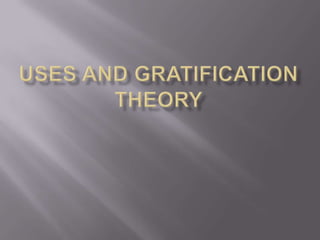Media Gratification Theory Explained in 5 Parts
•Transferir como PPTX, PDF•
0 gostou•364 visualizações
Denunciar
Compartilhar
Denunciar
Compartilhar

Mais conteúdo relacionado
Destaque
Destaque (12)
Semelhante a Media Gratification Theory Explained in 5 Parts
Semelhante a Media Gratification Theory Explained in 5 Parts (20)
6.4 - Relationship between Producers and Audience.pptx

6.4 - Relationship between Producers and Audience.pptx
Uses and gratifications theory presentation for COMM 2010

Uses and gratifications theory presentation for COMM 2010
Mais de abdullah97
Mais de abdullah97 (20)
Media Gratification Theory Explained in 5 Parts
- 2. The theory, unlike most media theory’s is not about what media does for people, its effects, although it’s instead what people use media for to satisfy their needs, wants and ‘gratification’. The theory first started to be noticed in the early 1940’s by researchers looking into radio listeners. In 1944 Herta Herzog was looking into why people choose specific forms of media, this is one of the earliest forms of research into the theory. The theory can be categorized into five parts , these are:
- 3. Personal integrative: This is the need of reassurance, to boost their selfesteem. Social integrative: It’s to create the need to socialize with friends and family, and build relations. Tension free needs: A way for people to relax and get away from their everyday worries and problems, to relieve stress. Affective needs: It’s all about peoples emotional needs, and includes a range of feelings and emotions which people use to satisfy themselves. Cognitive needs: People use media for information and knowledge.